Published
on 15
Sep 2021
|
All rights reserved.
|
|
|

|
|
Maserati
builds a supercar! And this time it is not by Ferrari.
|
|
Over the years, the sports
car strategy of FCA (or the preceding Fiat SpA) has been questionable.
Exotic sports cars like Maserati MC12, Alfa Romeo 8C Competizione and
4C suddenly popped up, which did not fit into the rest of the range or
the image of the brands. Lacking long-term planning and a consistent
strategy wasted the efforts of those halo cars. I guess the latest
Maserati MC20 could be the same.
The MC20 is a supercar, maybe not quite in the same league as the
Ferrari Enzo-based MC12, but it could be easily seen as a modern
Ferrari Dino. Priced at £187,000 in the UK, it matches a McLaren
600LT, and it has specifications to match. Powered by a 630hp
twin-turbo V6, dressed in carbon-fiber bones and skins, it is capable
of 202 mph and 0-60 in just 2.8 seconds. A Ferrari F8 is quicker still,
but at £204,000 it is in the radar of the new Maserati. This
would not have happened if not Ferrari spun off from FCA group in 2016.
The MC20 would not have happened without the help of Dallara, too. Its
carbon-fiber tub is designed and supplied by the latter (which built
the carbon tub of Alfa 4C as well). Its aerodynamics is also polished
at Dallara's wind tunnel. Without the help of the Italian racing
chassis expert, this car could not have been developed in only 24
months.
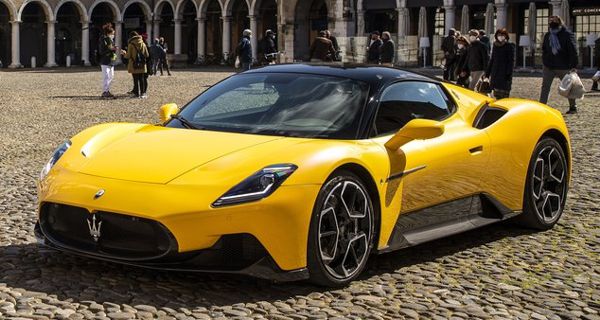
|
|
Dallara
helps building its chassis and polish its aerodynamics.
|
|
While the car looks compact, it is actually not. Both its 4669mm length
and 2700mm wheelbase eclipse those of Ferrari F8. DIN kerb weight is
claimed to be under 1500kg, pretty good. When fitted with optional
carbon-ceramic brakes (standard in UK), it tips the scale at 1475kg, 40
more than the F8 in the lightest form. The body panels are mostly
carbon-fiber, others are composites.
The MC20 has neither a rear spoiler nor any active aerodynamics aids,
so its drag coefficient is an unremarkable 0.38. However, it still
sports plenty of aero designs to generate downforce, such as a flat
bottom design, large diffusers and vortex generators at the front
underbody. The exterior design is sexy and exotic, something you might
thought coming from Maranello if not the trident logo and a nose shaped
to mirror MC12. The side view owes much to the theme of Ferrari
458/488/F8, sharing a low and flowing waistline. Like the latter, it
has engine intakes located at the top of the rear fenders, taking
advantage of clean air. At the back, however, the MC20 successfully
transfered the genes of GranTurismo into a mid-engined supercar.
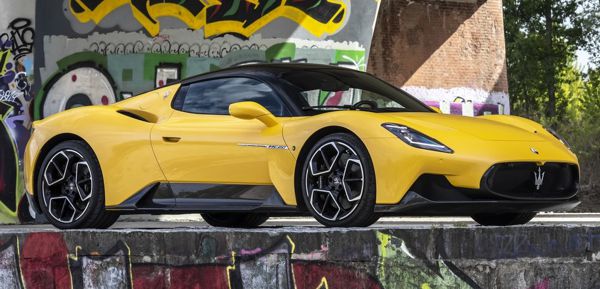
|
|
Who
says beautiful supecar must come from Maranello?
|
|
The carbon-fiber tub is bolted with front and rear extruded aluminum
subframes on which suspensions and powertrain are mounted. Suspensions
are forged aluminum double-wishbone at all corners, with virtual
steering axis to help keeping the front wheels perpendicular to the
ground, improving steering precision and grip. Adaptive dampers are
employed, as is a hydraulic device that jack up the front wheels by
40mm to avoid kerbs. Braking is provided by Brembo, with 380/350mm
steel discs or 390/360mm ceramic ones to choose from. The 20-inch
wheels are shod with Bridigestone 245/35 and 305/30 rubbers. The
Japanese tire maker seems eager to re-enter supercar market, as it
developed bespoke compounds and asymmetric tread pattern for the MC20.
Power comes from an all-new 3.0-liter twin-turbo V6 dubbed "Nettuno".
This is the world's most power-densed V6, producing 630 horsepower at
7500 rpm and translating to 210hp per liter. It is nearly the world's
most powerful V6, losing just 17 horses to the 3.5-liter mill of Ford
GT, but its specific output beats that engine as well as Alfa Romeo
Giulia GTA handsomely. It offers plenty of torque, too, with 538 lbft
of torque from 3000 to 5500 rpm, yet it will rev to a sky-high 8000
rpm, like a Ferrari V8 turbo. While Modena claims the engine is 100%
Maserati, it owes a lot to Ferrari's F154 V8 as well as Alfa Romeo's
V6. Road & Track had a detailed comparison between it and the
Ferrari V8 and found even its patent application listed the name of a
Ferrari engineer. It shares the same 88mm bore and 82mm stroke with the
engine of Ferrari SF90 Stradale, ditto dry-sump lubrication and
90-degree V-angle.
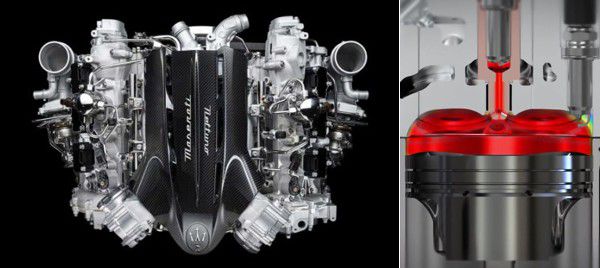
|
|
Nettuno
V6 could be the last innovative engine ever made to production, sadly.
|
|
However, the cylinder heads and fuel injection system are new,
featuring a patented "pre-chamber" technology to improve combustion
efficiency. Fuel is injected first into the "pre-chamber" located near
the injector and main spark plug, get burned, then propagate to the
main chamber through special holes which promote vortex. The fuel
injection has dual mode (direct and port), running at higher, 350-bar
pressure. There is also a secondary spark plug at each combustion
chamber to ensure smooth combustion when pre-chamber is not used.
Compression ratio is unusually high at 11.0:1.
It is refreshing to hear the Italian still introduces new engine
technologies at a time when all others have turned their investment to
electrification. However, even Maserati could not ignore the trend of
zero-emission, as legislation will kill combustion cars eventually. A
pure electric version of MC20 is under development and slated for
production in 2 year's time. Between now and then, Spider and a
track-oriented version will be added to support an optimistic business
plan which targets at 1500 cars a year.
As for transmission, surprisingly, the 8-speed twin-clutch gearbox
comes from not Getrag but Tremec, which serves also the mid-engined
Corvette. The American gearbox specialist must be proud to help driving
an Italian supercar. Between the engine and transmission is a limited
slip differential, which can be mechanical type or
electronic-controlled.
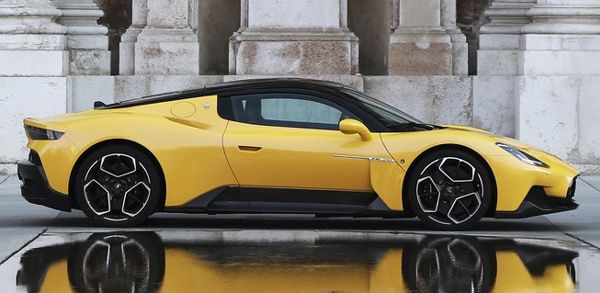 |
|
This
is really a sexy thing...
|
|
On the Road
The MC20 is really a sexy thing. It turns heads and has a sense of
occasion an Italian supercar deserves, something not even Bora and
Merak,
Maserati’s first mid-engined machines, could say. It makes an Audi R8
dull and
a Honda NSX ordinary.
The sense of occasion is amplified by the butterfly doors, which swing
up and forward to reveal a surprisingly accessible cockpit. Despite
the carbon-fiber tub hence the inevitable wide sills, the sills
are low and the door apertures are large. You simply sit on the sill,
swing your legs into the footwell and move your bum into the enveloping
Sabelt carbon-fiber bucket. Then you will find good head and shoulder
room for a supercar, good forward visibility and a rearward visibility
saved by a rearview camera, which is displayed at the roof mirror. The
seat is not very adjustable, but ergonomics is fundamentally sounded,
thanks to a low mounting position and good alignment with pedals and
steering wheel.
Interior design is definitely minimalist and professional. There is not
much style or luxury to speak of, but the Alcantara and
carbon-fiber-heavy environment looks purposeful – and unlike some
supercars, they don't come at extra cost. Both the digital instrument
and center touchscreen are 10.25-inch. Most interior
functions are controlled by the latter, leaving only the drive mode
selector on the transmission tunnel and a few other
buttons on the steering wheel. That wheel is great to hold, thanks to a
thick rim wrapped with Alcantara. A pair of carbon-fiber paddles behind
the wheel gives a tactile touch to the gearbox. On the downside, the
cabin offers few storage spaces. Luggage space is also strictly
supercar level, limited to an oven-hot, 101-liter boot behind the
engine and a 47-liter front boot.
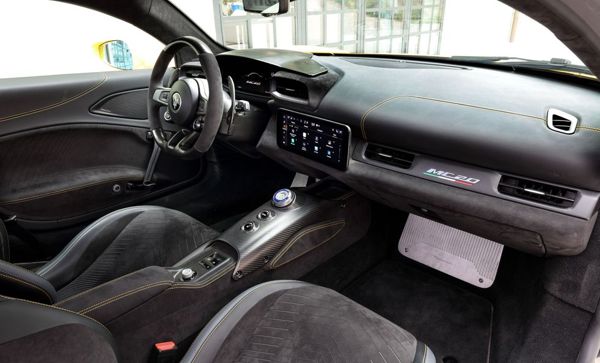
|
|
Butterfly
doors open to a surprisingly accessible cockpit.
|
|
Press the start button on the steering wheel, the V6 bursts into life.
At the default GT mode, the MC20 is surprisingly civilized, boring
even. The exhaust note is subdued, the gearshift and throttle response
are slow, while the steering is pretty light. You need to dial the
drive mode selector to Sport or, even better, Corsa to reveal the true
character of the Maserati. Doing so, the V6 wakes up with sharp
response and enthusiasm for rev. It is happy to chase the 8000 rpm
redline, like any great Italian motors should, yet there is still
plenty of mid-range torque on offer. This car is good for 0-124 mph in
8.8 seconds, good enough to beat a 911 Turbo S, McLaren GT, Audi R8 or
Lamborghini Huracan Evo, if not the likes of F8 or 720S.
But unlike the rivalling V8s and V10s, the Maserati V6 is not
overloaded with decibels or aural character. This is partly due to the
engine configuration – try a Honda NSX and you will see, partly because
Maserati doesn’t want to replicate a Ferrari or Lambo. It wants to be
the Roger Federer of supercar field – more refined, more gentleman but
no less performance. As a result, you hear some exhaust rasp but not
spine-tingling crackles, muffled turbo whoosh and wastegate whistles
instead of thundering howl.
This calmer character might suit a Maserati. While the MC20 is not
short of outright speed, its true quality is an effortless performance.
You don’t need to work hard to extract the best out of it. Sit back,
relax a
bit, use the broad spread of torque to overtake big AMG sedans and
RS-badged estates is equally amusing. It does so with a supple ride and
reassuring stability. Even on a challenging Italian mountain road, the
Maserati has suspension travel to spare. You can select soft or hard
suspension setting independent of the drive mode, so no need to
compromise ride quality with the rest of the car.
 |
|
Easier
to drive and more communicative than Ferrari.
|
|
On a track, it displays immense grip, rock-solid body control and
powerful braking as you would expect for a supercar. It can slide
progressively as well when the tail breakaway. However, the controls
are tuned to give the MC20 a very different character to its Ferrari
stablemate, and mostly for the better of it. While Ferrari’s steering
is shockingly direct at just 2.0 turns lock to lock, the Maserati’s is
not only slightly calmer at 2.2 turns, but also lighter and more
communicative, telling you a clear picture about the front end grip.
That's not a surprise though, as the car was engineered by the same man
responsible for Alfa Romeo Giulia QF. Likewise, the brake pedal has a
longer travel than the supercar norm. It gives a linear modulation that
allows you to drive smoothly at lower speeds, even in traffic jam.
Racing drivers would prefer the instant retardation of Ferrari, but a
firm foot will stop the Maserati just as effectively.
In fact, the MC20 feels quite like a big Alpine A110 or a Lotus Evora
with supercar performance. It is not the last word of speed or drama,
but it feels intuitive and trustable from the first corner. It has an
easy-going manner beyond the usual measures of ride quality or noise
suppression, but the way it communicates with you and responds in a
linear and predictable manner. The adequate control weights, the good
visibility, the vice-free power delivery etc. Ridiculously, this car is
named after Maserati Corsa (Racing), while the number represents the
year of introduction, but the strength of the MC20 actually lies in its
all-round manner, not just a track toy. If not the limitation of
accommodation and luggage space, it might just be used as a GT.
Flaws are few. The Tremec DCT is generally up to the job, but sometimes
could hesitate to downshift in auto mode. The interior could be more
stylish and better crafted. A louder exhaust mode would not be amiss. I
really hope this Maserati to succeed, but frankly, with a trident logo
at
its nose, you might wonder why not spend a little bit more and get a
Ferrari. However, if the new 296GTB and its V6 hybrid powertrain turn
out to be not as great as we hope for, the MC20 could easily emerge as
its substitution.
|
Verdict:      |
|